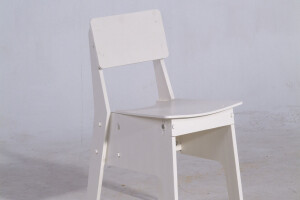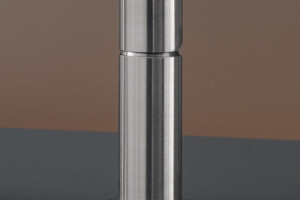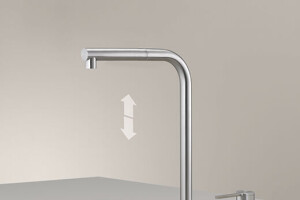The long and compact body, that allows the simultaneous vision of the two sides of the ridge from any environment, symbolizes the border, the threshold to cross, emerging as the main theme of the projectual research.
A concept that is develop in a different way in the ground floor (day) and the 1st floor (night). The project borrows, from the traditional rural home in Le Marche region, the compactness and the longitudinal development of the building with residential space in a row. The ground floor is a cut block, covered in varnished iron with anti rust primer.
The first floor, as though suspended, is composed by a more closed and intimate section and by an hybrid, inner and external space, surround by a perforated membrane. The two levels have different connections with the external space. On the ground floor the cyclic theory of the vertical cut allows visual and physical permeability.
The body of the building can be crossed in more than one position: the patio entrance, the living and bathroom/ spa. In the closed block of the first floor, an unusual window, with kaleidoscopic viewfinders head towards the landscape, giving the possibility to look out at the two counterposed slopes from the same position. The relation with the exterior changes by moving close to them, allowing the entrance of the amplified surrounding panorama. The emptiness that springs in the dialectical scheme internal-external of the project, bounded by walls (from the open space of the patio and the outside catwalk, to the more intimate area of the bedrooms, arriving to the area filtered from curtains on the first floor) is important to break up what unusually tends to occupy in a stable and immobilizing way.
The created space is concave, receptive, permitting the external space to enter and to the residents to enjoy it with simplicity. An ideal line of energy (a cosmic axis) of which the inhabitant can feed himself. He can pass through, from north to south, from the mountains to the sea. Suspension and dizziness are wanted feelings, enhanced by the absence of a conventional railing in the catwalk that distributes the spaces for the whole length of the house, replaced by an ethereal henhouse net. The blocks and the single parts of the building could be easily identified, having the proportions of an assembly kit, an out of scale construction game composed by white and red pieces of which it simple to imagine even the assembly process. The project is minimized, according to a simple thought based on the concept rather than formal choices. The rhythm of the openings and of the coating of the block on the ground floor is modular, cyclical, and follows a sinusoidal law; the same is reflected in the diaphragm- space on the first floor, in the wood partition than sustains the tissue.
The house is located on the outskirts of the urban space, where fields grow; the permeability of the soil is left to its maximum, with the grass that touches the perimeter of the house and with the minimum surface of outdoor paving that is detached, isolated from the house. There is no fence to demarcates the private property. A swathe of grass surrounds ideally the house in the field (cultivated in rotation with grain, barley, sunflower) expanding it. The attempt is to break the border, without following the protocol for which the private housing space is split up from farm work.
Regarding the interior and the furniture (all customized designed) the purpose was to avoid the contemporary language made of bright, luxury labels and design of contemporary fashion. Searching for an authenticity, like an “inherited” space, to pass down itself as witness, imagining it almost as though temporary (nomad, camping); a light space, flexible, like pre-existing, that suddenly we can take back, no finery and no luxury which belongs to home of the farming tradition. The furniture is in white painted ash wood or in blockboard pinewood panels (only for the doors). Countertops, tables, sinks and basin are designed in cement and quartz.
The structure of the building is in steel while the portion in tissue is in laminated timber. The pure and neutral block of the first floor is finished with self-cleaning plaster in all its surfaces. The iron blades of the ground floor, are showed in a open position on the ground floor, contain drains and ventilation.
The house has bioclimatic and insolvency assets that permits a thermal gain in the cold months and a natural air conditioning (there is no air conditioning device) in the hot ones, thanks to the crossed ventilation and to the effect chimney.
The doors of the balcony can stay open without any obstruction, lean against pilasters, thick blades that hold up and split the edifice. In this way the inner space become an outside-covered space and the living area turns into an enclosed gazebo in the house to be used not only in the summer season.
























































